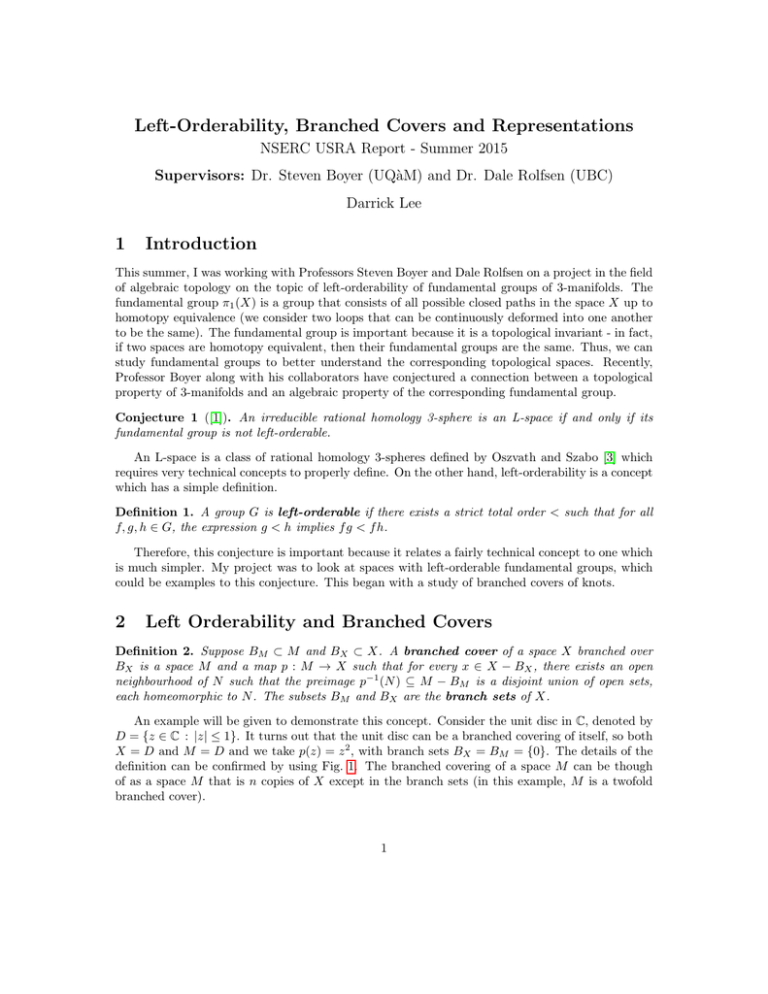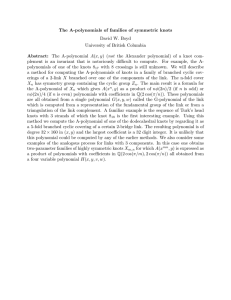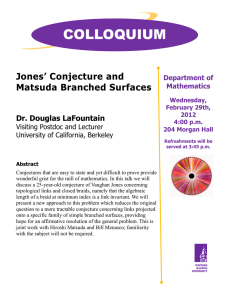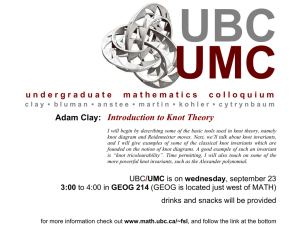Left-Orderability, Branched Covers and Representations
advertisement

Left-Orderability, Branched Covers and Representations
NSERC USRA Report - Summer 2015
Supervisors: Dr. Steven Boyer (UQàM) and Dr. Dale Rolfsen (UBC)
Darrick Lee
1
Introduction
This summer, I was working with Professors Steven Boyer and Dale Rolfsen on a project in the field
of algebraic topology on the topic of left-orderability of fundamental groups of 3-manifolds. The
fundamental group π1 (X) is a group that consists of all possible closed paths in the space X up to
homotopy equivalence (we consider two loops that can be continuously deformed into one another
to be the same). The fundamental group is important because it is a topological invariant - in fact,
if two spaces are homotopy equivalent, then their fundamental groups are the same. Thus, we can
study fundamental groups to better understand the corresponding topological spaces. Recently,
Professor Boyer along with his collaborators have conjectured a connection between a topological
property of 3-manifolds and an algebraic property of the corresponding fundamental group.
Conjecture 1 ([1]). An irreducible rational homology 3-sphere is an L-space if and only if its
fundamental group is not left-orderable.
An L-space is a class of rational homology 3-spheres defined by Oszvath and Szabo [3] which
requires very technical concepts to properly define. On the other hand, left-orderability is a concept
which has a simple definition.
Definition 1. A group G is left-orderable if there exists a strict total order < such that for all
f, g, h ∈ G, the expression g < h implies f g < f h.
Therefore, this conjecture is important because it relates a fairly technical concept to one which
is much simpler. My project was to look at spaces with left-orderable fundamental groups, which
could be examples to this conjecture. This began with a study of branched covers of knots.
2
Left Orderability and Branched Covers
Definition 2. Suppose BM ⊂ M and BX ⊂ X. A branched cover of a space X branched over
BX is a space M and a map p : M → X such that for every x ∈ X − BX , there exists an open
neighbourhood of N such that the preimage p−1 (N ) ⊆ M − BM is a disjoint union of open sets,
each homeomorphic to N . The subsets BM and BX are the branch sets of X.
An example will be given to demonstrate this concept. Consider the unit disc in C, denoted by
D = {z ∈ C : |z| ≤ 1}. It turns out that the unit disc can be a branched covering of itself, so both
X = D and M = D and we take p(z) = z 2 , with branch sets BX = BM = {0}. The details of the
definition can be confirmed by using Fig. 1. The branched covering of a space M can be though
of as a space M that is n copies of X except in the branch sets (in this example, M is a twofold
branched cover).
1
(N)
p-1p-1
(N)
M
X
N
pp-1-1(x)
(x)
p
−→
x
pp-1-1(x)
(x)
p-1-1(N)
p
(N)
Figure 1: Example of a branched cover of the unit disc.
Definition 3. A knot K is a subset of S 3 = {(x, y, z, t) ∈ R4 | x2 + y 2 + z 2 + t2 = 1} that is
homeomorphic to a circle S 1 = {(x, y) ∈ R2 | x2 + y 2 = 1}. A branched cover of a knot K is a
branched covering of S 3 where the branch set is the knot K.
Figure 2: The trefoil knot, an example of a knot.
Hu [2] proved a sufficient condition for the cyclic branched cover of a knot to be left-orderable.
She applied this condition to show that a large class of two-bridge knots had only finitely many
branched covers which are not left-orderable. Tran [6] also applied this condition to another class
of two-bridge knots called double twist knots to show they had the same property. Hu’s condition says that if there exists a real parabolic representation of the knot group, then only finitely
many branched covers are not left-orderable. Thus, my project was to investigate real parabolic
representations of yet another class of two bridge knots.
3
Representations of Knot Groups
Definition 4. Suppose K is a knot. A real representation of the knot group π1 (S 3 − K) is
a homomorphism ρ : π1 (S 3 − K) → SL2 (R), where SL2 (R) is the set of 2 × 2 real matrices
with determinant 1. A representation is called parabolic if some set of meridional generators of
π1 (S 3 − K) are mapped to elements of trace 2.
In [4], Riley showed that the existence of real parabolic representations corresponded to the
existence of real roots of a polynomial, now called the Riley polynomial. In addition, he conjectured
a relationship between the number of such representations and the signature of the knot.
Conjecture 2 ([4]). Suppose K is a two-bridge knot. Then π1 (XK ) has at least
parabolic representations, where σ(K) is the signature of the knot.
1
2 |σ(K)|
real
For my project, I was able to verify Riley’s conjecture for two classes of two bridge knots (in
Schubert’s normal form notation [5]): the (4mn + 1, n) and (4mn + 2n − 1, n) knots, where m > 0,
n is odd and n > 1. It turns out the signature of these knots is nonzero, so there exists at least one
representation, so Hu’s condition can be applied to show that only finitely many branched covers
of these knots are not left-orderable.
2
References
[1] Steven Boyer, Cameron McA. Gordon, and Liam Watson. On l-spaces and left-orderable fundamental groups. Mathematische Annalen, 356(4):1213–1245, 2013.
[2] Y. Hu. Left-orderability and cyclic branched coverings. ArXiv e-prints, November 2013.
[3] Peter Ozsváth and Zoltán Szabó. On knot floer homology and lens space surgeries. Topology,
44(6):1281 – 1300, 2005.
[4] Robert Riley. Nonabelian representations of 2-bridge knot groups. The Quarterly Journal of
Mathematics, 35(2):191–208, 1984.
[5] Horst Schubert. Knoten mit zwei brücken. Mathematische Zeitschrift, 65(1):133–170, 1956.
[6] A. T. Tran. On left-orderability and cyclic branched coverings. ArXiv e-prints, November 2013.
3




